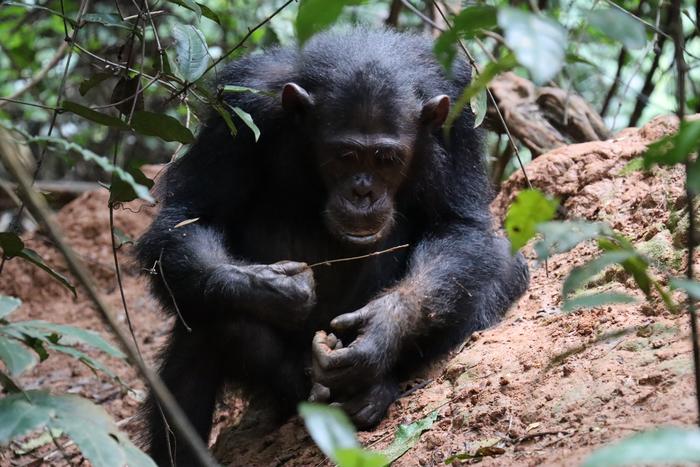A team of interdisciplinary researchers from prominent institutions, including the University of Oxford, the Max Planck Institute for Evolutionary Anthropology, and the Jane Goodall Institute, have uncovered remarkable findings about the engineering abilities of chimpanzees in Gombe Stream National Park, Tanzania. This groundbreaking research reveals that these intelligent primates exhibit a sophisticated understanding of material properties when crafting tools for termite fishing, highlighting a level of behavior previously thought to be unique to humans and a few other species. The study not only sheds light on the cognitive capacities of chimpanzees but also carries significant implications for understanding the evolutionary trajectory of human tool-making abilities.
The crux of the study revolves around the strategic selection of specific plant materials by chimpanzees, who choose species that allow them to create more flexible tools for fishing termites. Researchers conducted a comparative analysis between plants that chimpanzees regularly employed and those that were readily available but remained untouched. This meticulous approach led to startling insights into the mechanical properties of the materials chimpanzees prefer, demonstrating an innate grasp of physics that laid the groundwork for their tool-making choices.
A portable mechanical tester was utilized on-site by the study’s lead author, Alejandra Pascual-Garrido. The results were nothing short of astounding; materials that chimpanzees favored for their tool-making were found to be significantly more flexible than those they avoided. Specifically, the research indicated that the plants never utilized by the chimpanzees were a staggering 175% more rigid, emphasizing the primates’ selective behavior in choosing materials that optimize their foraging efficacy.
Moreover, the research findings drew correlations between the usage patterns of the chimpanzees and the mechanical attributes of the plants. Among plants located near termite mounds, those with evident signs of regular use by the apes were consistently more flexible compared to adjacent plants that showed no usage. This correlation underscores the behavioral adaptability of chimpanzees, suggesting that they have developed a kind of “folk physics” that informs their material choices in crafting tools.
Pascual-Garrido stated that this study represents the first comprehensive evidence of wild chimpanzees actively selecting tool-making materials based on their mechanical properties. Such findings point towards a deep-rooted cultural behavior among chimpanzee communities that transcend geographic boundaries, as certain plant species favored for tool-making in Gombe are similarly utilized by chimpanzee populations thousands of kilometers away.
This suggests that the principles driving these choices are not only shared within local communities but may be a hallmark of chimpanzee culture itself. The ramifications of this understanding extend into the realm of human evolutionary studies, with implications for how early humans may have approached tool-making. The study’s importance lies in bridging the gap between primate behavior and human technological evolution, allowing for a re-examination of the cognitive processes involved in tool fabrication.
The research raises intriguing questions about how these engineering capabilities are acquired and disseminated among chimpanzee families. One hypothesis posits that younger chimpanzees learn by observing their mothers or other adults, acquiring knowledge of which materials yield the most effective tools. Additionally, the study prompts inquiries into whether the mechanical principles governing tool material selection are applicable across a range of foraging behaviors, including those used for harvesting ants or gathering honey.
From an evolutionary biology perspective, the findings underscore a continuity in tool-making philosophies that might have persisted throughout human history, despite the ephemeral nature of perishable materials like wood. Adam van Casteren, a biomechanist from the Max Planck Institute, elaborates on the importance of understanding these mechanical concepts, suggesting that they provide a valuable framework for exploring the technological capabilities that likely characterized our early ancestors.
Interestingly, the research aligns with recent discussions in anthropology about the cognitive parallels between humans and their closest relatives. It emphasizes that tool-making is not merely a mechanical endeavor but also a cognitive one, requiring foresight and an understanding of material properties. The breadth of this study lays a foundation for future explorations into the cognitive architectures that inform such behaviors in non-human species.
In conclusion, the findings from Gombe Stream National Park serve as a call to action for further investigations into primate behavior and cognition. The results not only provide insight into the selective habits of chimpanzees but also raise essential questions about the intersection of animal and human evolution. The multifaceted nature of engineering in the animal kingdom invites a broader understanding of intelligence and adaptability, particularly within the context of tool-making.
These revelations about chimpanzees compel us to reassess assumptions regarding the uniqueness of human technological prowess. If these animals can demonstrate advanced material selection and engineering capabilities, what does this mean for our understanding of the origins of human ingenuity? The groundwork has been laid for an exciting area of inquiry that promises to reshape our understanding of the evolutionary narrative concerning tool-making.
The study’s implications underscore an urgent need for reevaluation of behavioral norms among non-human species, challenging us to look closely at the evolutionary threads that connect our lives with those of other intelligent beings on the planet. Such explorations could unveil the integral aspects of our shared lineage and lead to groundbreaking discoveries in both primate research and human evolutionary studies, fostering a dialogue between the past, present, and future of tool use.
Subject of Research: Animals
Article Title: Engineering skills in the manufacture of tools by wild chimpanzees
News Publication Date: 24 March 2025
Web References:
References:
Image Credits: Credit: Alejandra Pascual-Garrido
Keywords: Anthropology, Anthropogenesis, Human origins, Human evolution, Early humans, Social sciences, Evolution, Evolutionary biology
Tags: advanced primate intelligenceanimal behavior and tool usechimpanzee tool makingcognitive capacities of chimpanzeesengineering abilities of primatesevolutionary anthropology researchGombe Stream National Park studiesimplications for human evolutioninterdisciplinary research teamsmaterial selection in tool usemechanical properties of plant materialstermite fishing techniques





